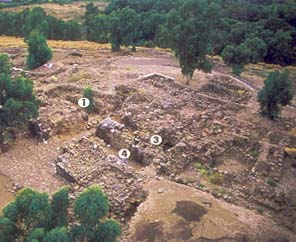Image Details

Courtesy Bethsaida Excavations
Welcome to Bethsaida. Two gates—an outer and inner entranceway—guarded Bethsaida in the ninth century B.C.E. The photo shows the inner gate; soundings from ground-penetrating radar lead the excavators to believe that the city’s tenth-century B.C.E. gateway lies directly below.
Two towers, each 20 by 32 feet, flanked the inner gate; four chambers, measuring about 12 by 32 feet each, lay behind the towers. The complex is the largest and best-preserved example of a four-chambered gate ever discovered in Israel. In the first chamber (marked 4 on the plan) beyond the right tower, excavators discovered 15 arrows and spearheads and a thick ash layer—evidence of the conquest of the city by the Assyrian ruler Tiglath-pileser III in 734 B.C.E. The next chamber on the right (3 on the plan) served as a granary: Fully one ton of burnt barley lay in it, further evidence of Bethsaida’s defeat by the Assyrians. (Chamber 2 had not yet been excavated when this photo was taken.)
